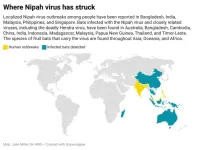(Press-News.org) Embargoed for release until 5:00 p.m. ET on Monday 20 January 2025
@Annalsofim
Below please find summaries of new articles that will be published in the next issue of Annals of Internal Medicine. The summaries are not intended to substitute for the full articles as a source of information. This information is under strict embargo and by taking it into possession, media representatives are committing to the terms of the embargo not only on their own behalf, but also on behalf of the organization they represent.
----------------------------
1. Gene classifier tests for prostate cancer may influence treatment decisions despite lack of evidence for long-term outcomes
Abstract: https://www.acpjournals.org/doi/10.7326/ANNALS-24-00700
Editorial: https://www.acpjournals.org/doi/10.7326/ANNALS-24-03630
URL goes live when the embargo lifts
A systematic review found that while genomic classifier (GC) tests may influence risk classifications or treatment decisions for patients with localized prostate cancer (PCa), there is a need for better data on their cost-effectiveness, clinical utility, and their impact on racial and ethnic groups, particularly Black men. The study is published in Annals of Internal Medicine.
Prostate cancer is the most common cancer among men, with cases ranging from barely noticeable to highly aggressive ones requiring serious treatment. Determining who needs which type of treatment remains a significant challenge. Traditionally, clinicians rely on tools like the NCCN guidelines, which assess tumor stage, PSA levels, and Gleason grades. However, these tools are not perfect and can sometimes lead to overtreatment or undertreatment. Tests like Decipher by Veracyte, Prolaris by Myriad Genetics, and Oncotype DX Genomic Prostate Score (GPS) by MDx offer a genetic snapshot of tumor aggressiveness, potentially catching things that clinical tools might miss. Despite the potential of these tests, their use in clinical practice is inconsistent due to conflicting guidelines.
Researchers from the Department of Veterans Affairs reviewed 19 studies to assess the impact of these tissue-based genomic tests on risk stratification and treatment decisions for localized prostate cancer. The researchers analyzed test type, quality, population characteristics, risk reclassification and recommended and/or received treatment intensity and found that in low risk of bias observational studies, most patients with low or very low baseline risk did not see an increase in risk classification after GC testing. This pattern differed across GC test types, however, with GPS-based studies finding 0% - 11.9% of patients were reclassified to a higher risk category versus Decipher-based studies finding 12.8% to 17.1% reclassified to a higher risk category. In a randomized trial, reclassification to higher risk was more prevalent than in the observational studies examined. Observational studies indicated that GC testing often led to more patients opting for conservative management options like active surveillance.
The researchers note that the differences in results from observational and randomized trials emphasize the need for well-designed trials evaluating the impact of GC tests in management of PCa to inform patient-clinician decision-making.
Media contacts: For an embargoed PDF, please contact Angela Collom at acollom@acponline.org. To speak with corresponding author Amir Alishahi Tabriz, MD, PhD, MPH, please email Kim Polacek at Kim.Polacek@Moffitt.org.
----------------------------
2. VA and DoD publish updated stroke rehabilitation clinical guidelines with focus on interdisciplinary approach
Abstract: https://www.acpjournals.org/doi/10.7326/ANNALS-24-02205
Editorial: https://www.acpjournals.org/doi/10.7326/ANNALS-24-03568
URL goes live when the embargo lifts
The U.S. Department of Veterans Affairs (VA) and U.S Department of Defense (DoD) updated their 2019 clinical practice guideline (CPG) for the management of stroke rehabilitation to provide primary care providers with recommendations for the management of adult stroke patients. A summary of these guidelines relevant to internal medicine physicians and rehabilitation professionals is published in Annals of Internal Medicine.
Researchers developed 12 questions using the PICOTS (population, intervention, comparator, outcomes, timing of outcomes measurement, and setting) framework focusing on rehabilitation methods in the following areas: motor; cognitive, speech, or language; dysphagia; spasticity; mental or behavioral health; sensory rehabilitation; neglect; technology-assisted tools; settings and models of care; and caregiver support. To glean insights for these questions, they conducted a systematic review of studies published between July 2018 and May 2023. The key areas examined in the 2024 guideline are: transitions to community, motor therapy, dysphagia, aphasia, cognition, mental health, telehealth, and noninvasive brain stimulation.
To ease transitions to community for stroke patients, physicians can consider case management and psychosocial interventions. For motor therapy, evidence supports the implementation of task-specific practice, mirror therapy, rhythmic auditory stimulation, electrical stimulation and botulinum toxin for spasticity management. Chin tuck against resistance and respiratory muscle strength training can help manage issues relating to dysphagia, aphasia and cognition. To treat mental health conditions after a stroke, clinicians can consider selective serotonin reuptake inhibitors (SSRIs), psychotherapy and/or mindfulness-based therapies. Clinicians should also consider an interdisciplinary team-based approach to stroke rehabilitation and use these guidelines as a supplement to the Guidelines for Adult Stroke Rehabilitation and Recovery from the American Heart Association and American Stroke Association. The full Management of Stroke Rehabilitation (2024) – VA/DoD Clinical Practice Guidelines can be accessed at https://www.healthquality.va.gov/guidelines/Rehab/stroke.
Media contacts: For an embargoed PDF, please contact Angela Collom at acollom@acponline.org. To speak with corresponding author Blessen C. Eapen, MD, please email blessen.eapen2@va.gov.
----------------------------
Also new in this issue:
Germline UBA1 Variant With Somatic Amplification in a Woman With Inflammatory Diseases and Myelodysplastic Syndrome
Maria Creignou, MD, PhD et al.
Case Report
Abstract: https://www.acpjournals.org/doi/10.7326/L4-0125
END
Gene classifier tests for prostate cancer may influence treatment decisions despite lack of evidence for long-term outcomes
2025-01-20
ELSE PRESS RELEASES FROM THIS DATE:
KERI, overcomes the biggest challenge of the lithium–sulfur battery, the core of UAM
2025-01-20
Dr. Park Jun-woo's team at KERI's Next Generation Battery Research Center has overcome a major obstacle to the commercialization of next-generation lithium–sulfur batteries and successfully developed large-area, high-capacity prototypes.
The lithium–sulfur battery, composed of sulfur as the cathode (+) and lithium metal as the anode (-), has a theoretical energy density more than eight times that of lithium-ion batteries, demonstrating significant potential. Additionally, it uses abundant sulfur (S) instead of expensive rare earth elements, making it cost-effective and environmentally ...
In chimpanzees, peeing is contagious
2025-01-20
A new study reported in the Cell Press journal Current Biology on January 20 is the first to describe a phenomenon researchers refer to as “contagious urinations.” The study in 20 captive chimpanzees living at the Kumamoto Sanctuary in Japan shows that, when one chimp pees, others are more likely to follow.
“In humans, urinating together can be seen as a social phenomenon,” says Ena Onishi of Kyoto University.
“An Italian proverb states, ‘Whoever doesn’t pee in company is either a thief or a spy’ (Chi non piscia in compagnia o è ...
Scientists uncover structure of critical component in deadly Nipah virus
2025-01-20
Scientists at Harvard Medical School and Boston University Chobanian & Avedisian School of Medicine have mapped a critical component of the Nipah virus, a highly lethal bat-borne pathogen that has caused outbreaks in humans almost every year since it was identified in 1999.
The advance, described Jan. 20 in Cell, brings scientists a step closer to developing much-needed medicines. Currently, there are no vaccines to prevent or mitigate infection with the Nipah virus and no effective treatments for the disease ...
Study identifies benefits, risks linked to popular weight-loss drugs
2025-01-20
Demand for weight-loss medications sold under brand names such as Ozempic and Wegovy continues to surge, with a recent study reporting one in eight Americans has taken or is currently using the drugs to treat diabetes, heart disease or obesity.
Formally, these drugs are known as glucagon-like peptide-1 receptor agonists (GLP-1RA) and include Mounjaro and Zepbound. Informally, media, patients and even some physicians have dubbed GLP-1 medications as “miracle drugs” because of the profound weight loss among users. While these health benefits are well established, information is sparse on the drugs’ effects across ...
Ancient viral DNA shapes early embryo development
2025-01-20
Over half of our genomes consists of thousands of remnants of ancient viral DNA, known as transposable elements, which are widespread across the tree of life. Once dismissed as the "dark side" of the genome, researchers at Helmholtz Munich and Ludwig-Maximilians-Universität (LMU) have now revealed their crucial role in early embryo development.
Unanswered Questions About the Role of Ancient Viral DNA
Transposable elements, remnants of ancient viral DNA, are reactivated during the first hours and days following fertilization. ...
New study paves way for immunotherapies tailored for childhood cancers
2025-01-20
Researchers at Karolinska Institutet and the Astrid Lindgren Children’s Hospital in Sweden have determined how children’s immune systems react to different kinds of cancer depending on their age. The study, which is published in the journal Cell, reveals significant differences between the immune response of children and adults, and has the potential to lead to new tailored treatments for children with cancer.
“The activation of the immune system is crucial to our ability to fight cancer, but differs between children and adults,” says Petter Brodin, professor of paediatric immunology at the ...
Association of waist circumference with all-cause and cardiovascular mortalities in diabetes from the National Health and Nutrition Examination Survey 2003–2018
2025-01-20
Background and objectives
Waist circumference (WC) is closely associated with metabolic diseases, including diabetes mellitus (DM), metabolic syndrome, and mortality. However, the correlation between WC and mortality varies across populations and has rarely been examined specifically in patients with DM. In this study, we explored the relationships between WC and both all-cause and cardiovascular mortalities among individuals with DM.
Methods
Participants from the National Health and Nutrition Examination Survey 2003–2018 included 3,151 women and 3,473 men with DM who had baseline WC measurements. Survival data were collected from enrollment until December 31, 2019. ...
A new chapter in Roman administration: Insights from a late Roman inscription
2025-01-20
Archaeologists have uncovered a rare Tetrarchic boundary stone at the site of Abel Beth Maacah in northern Israel. Originally marking land borders under Roman Emperor Diocletian’s tax reforms, the stone provides insight into ancient land ownership, local settlement patterns, and imperial administrative practices. The discovery also introduces two previously unknown place names, expanding our understanding of the region’s historical geography and socio-economic landscape.
Archaeologists Prof. Naama Yahalom-Mack and Dr. Nava Panitz-Cohen from the Institute of Archaeology at the Hebrew University, and Prof. Robert Mullins from Azusa Pacific University have uncovered a significant ...
Global trust in science remains strong
2025-01-20
A global survey spanning 68 countries reveals that public trust in scientists is still high. Led by the University of Zurich and ETH Zurich, a team of 241 researchers conducted the largest post-pandemic study of trust in science, societal expectations and public views on research priorities.
Trust in scientists is at a moderately high level worldwide, according to a new study. This is the conclusion of an international team of 241 researchers led by Viktoria Cologna of ETH Zurich and Niels G. Mede of the University of Zurich (UZH). “Our results show that most people in most countries have a relatively ...
New global research reveals strong public trust in science
2025-01-20
A new international study on public trust in science, conducted across 68 countries, has found that most people trust scientists and believe they should be more involved in society and policymaking. Further, a majority of survey participants believe that scientists should be more involved in society and policymaking.
Published in Nature Human Behaviours (pre print link), this research was conducted by TISP, a Harvard University-based consortium led by Dr Viktoria Cologna (Harvard University, RTH Zurich) and Dr Niels G Mede (University of Zurich), which includes 241 researchers from 169 institutions worldwide, including the University of Bath.
The study, which includes 71,922 respondents—2,008 ...




